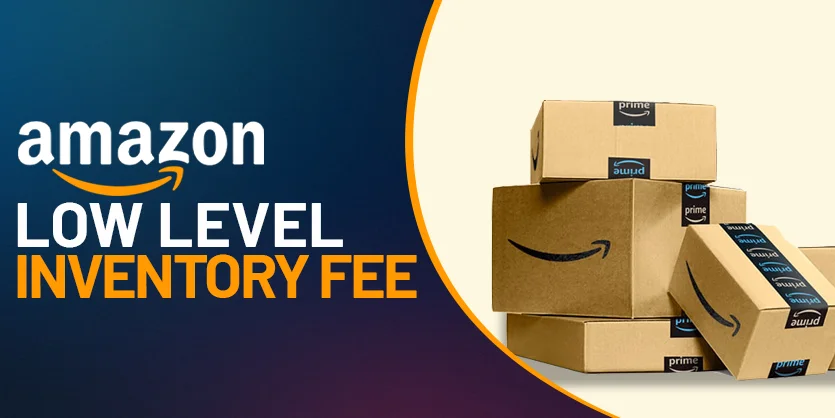Effective April 1, 2024, Amazon is introducing a new fee for standard-sized products that consistently maintain low inventory levels relative to customer demand. This fee aims to address challenges in product distribution, improve delivery speed, and manage shipping costs. In this article, we will delve into the details of Amazon’s new FBA Low Inventory Level Fees.
A Quick Overview of This Article:
- Amazon’s Low-Inventory-Level Fee
- How the Low-Inventory-Level Fee is Calculated
- How to Check Historical Days Of Supply
- Strategies to Minimize or Avoid the Low-Inventory-Level Fee
- Where won’t the Low Inventory Level Fee Apply
- Final Thoughts
Amazon’s Low-Inventory Level Fee
Amazon has introduced a new fee structure targeting “standard-sized products with consistently low inventory levels relative to customer demand.” This fee is tied to the distribution capabilities and shipping costs associated with Fulfillment by Amazon (FBA). The fee will be applicable to products when inventory levels, measured in terms of historical days of supply, fall below 28 days. This measurement takes into account both short-term (last 30 days) and long-term (90 days) metrics. The fees are tiered based on the product size and historical days of supply: 0-14 days, 14-21 days, and 21-28 days. New sellers and new products will receive exemptions for either six months or a year. To mitigate or entirely avoid the low-inventory-level fee, sellers can send additional units, ensuring that the short-term historical days of supply exceed 28 days.
How Low-Inventory-Level Fee is calculated?
The Low-Inventory-Level Fee is an additional charge applied to the Fulfillment by Amazon (FBA) fee for eligible products. The fee amount varies depending on the size tier and shipping weight of the product. Below is a detailed breakdown of the fee structure applicable for different historical days of supply, effective from April 1, 2024, and beyond:
| April 1, 2024 and after | ||||
| 2024 size tier | Shipping weight | Low-inventory-level fee | ||
| 0-14 historical days of supply | 14-21 historical days of supply | 21-28 historical days of supply | ||
| Small standard | Up to 16 oz | $0.89 | $0.63 | $0.32 |
| Large standard | Up to 3 lb | $0.97 | $0.70 | $0.36 |
| Large standard | 3+lb to 20 lb | $1.11 | $0.87 | $0.47 |
To calculate these fees, sellers must first identify the product’s size tier and then determine its shipping weight. For small standard products, the shipping weight is based on unit weight, while large standard products use the greater unit weight or dimensional weight. This fee structure aims to incentivize sellers to maintain optimal inventory levels, ensuring a smoother fulfillment process while reflecting the associated costs based on historical days of supply.
How to Check Historical Days Of Supply
The historical days of supply metrics play a crucial role in inventory management, providing insights into how long it takes for a specific product to be sold or utilized based on historical data. This metric is typically calculated by dividing the average inventory for a specified period by the average daily usage or sales during that same timeframe. Here’s a step-by-step guide on how to access and interpret your historical days of supply on Amazon Seller Central:
From your Amazon Seller Central go to the “Inventory” and click on FBA Inventory.
Once in the FBA Inventory section, you will find the Historical days of supply for each Parent ASIN.
How to Minimize or Avoid the Low-Inventory-Level Fee?
To effectively minimize or completely avoid the low-inventory-level fee, sellers can implement strategic inventory management practices. One approach is to make recent enhancements to inventory levels by sending in additional units. This action ensures that the short-term (last 30 days) historical days of supply for the product exceed the critical threshold of 28 days. Notably, if a product’s short-term historical days of supply surpass 28 days, the low-inventory-level fee will not be applied.
Furthermore, for products where inventory is manually supplied by sellers, proactive management of the product’s long-term (last 90 days) historical days of supply becomes crucial. By staying attentive to the overall inventory trends and ensuring a healthy balance between supply and demand, sellers can prevent falling into the low-inventory category that triggers fees.
In addition to managing inventory levels, sellers have the option to enroll their products in automatic restocking through Amazon Warehousing and Distribution. A key metric to consider is the Auto-Replenishment Ratio (ARR), which is calculated daily. If over 70% of your Fulfillment by Amazon (FBA) units have been auto-replenished in the past 91 days, you become eligible for an exemption from the low-inventory-level fee. This ratio is assessed regularly, and sellers can check the waiver status every Monday. For instance, if your product’s ARR is 70% or more on Monday, you will not incur the low-inventory-level fee for units shipped throughout that week, spanning from Monday to Sunday. This automated restocking system provides an effective means to maintain optimal inventory levels and avoid associated fees.
Where won’t the Low Inventory Level Fee Apply?
When selling standard-sized products on Amazon, a fee related to low inventory and historical days of supply below 28 days may be imposed. However, certain exceptions exist, exempting sellers from the low-inventory-level fee:
- New Seller Exemption: New sellers on Amazon receive a 365-day exemption from the Low Inventory Level Fee, starting from their initial inventory-received date. This extended grace period is designed to support sellers who are in the early stages of establishing their presence on the platform. During this period, new sellers can navigate the marketplace without the burden of additional charges for low inventory, facilitating a smoother entry into the competitive landscape.
- New FBA Product Exemption: Sellers introducing a new product to Fulfillment by Amazon (FBA) benefit from a 180-day exemption from the low inventory fee after the initial inventory-received date. This exemption serves as an incentive for sellers to diversify their product offerings and encourages innovation and expansion without the immediate concern of incurring added fees during the critical introductory period.
- Automatic Restock by AWD: Products that are automatically restocked through Amazon Warehousing and Distribution (AWD) are not subject to the low inventory fee. This exception applies to products efficiently managed and replenished by Amazon’s automated systems. Automatic restocking streamlines the inventory management process for sellers, ensuring a consistent supply chain and mitigating the risk of low inventory fees.
Final Thoughts
Successfully navigating Amazon’s updates is essential for sellers. Though the low inventory level fee presents a new challenge, grasping the nuances of these changes and aligning your inventory strategies accordingly is key to overcoming obstacles. Stay well-informed, proactively send additional units, and maintain vigilant control over your inventory to guarantee a seamless experience on the Amazon marketplace.
If you have any queries, please let us know through the comment box or email us at info@ecomclips.com. We understand that every situation is different, so we offer a personalized approach to our service.
To know more about Amazon, please check out our other blog. Also, you can check our YouTube videos related to Amazon.
Amazon FBA Inventory Planning | IPI Score and Re-Stock Items to FBA Guide 2023
Amazon SEO: 7 Tips to Optimize Your Listings and Rank High | Boost Your Listings & Increase Sales
Variation Wizard in Amazon | Use Variation Wizard to add a Variation to Existing Listing on Amazon



